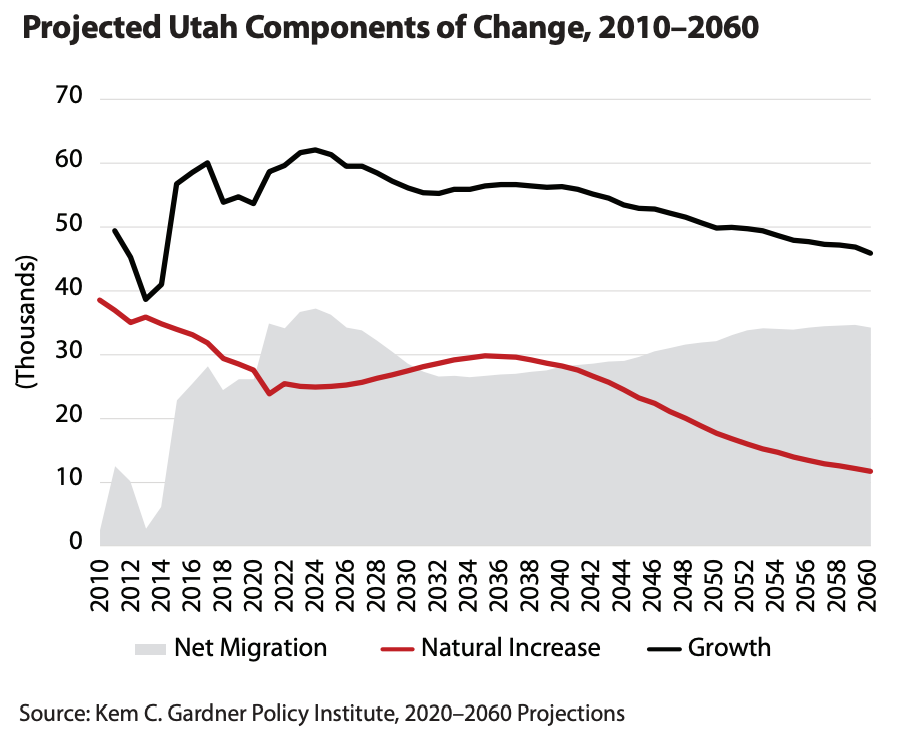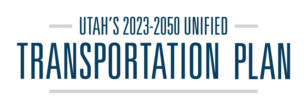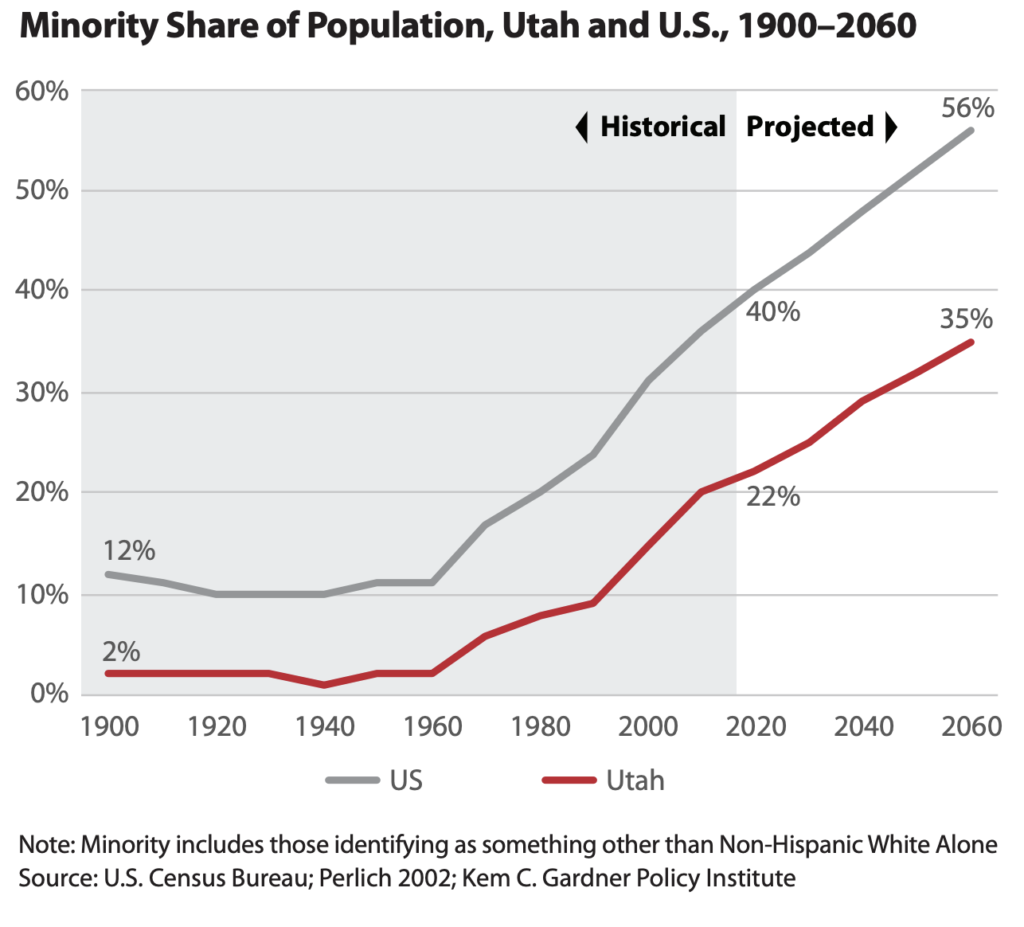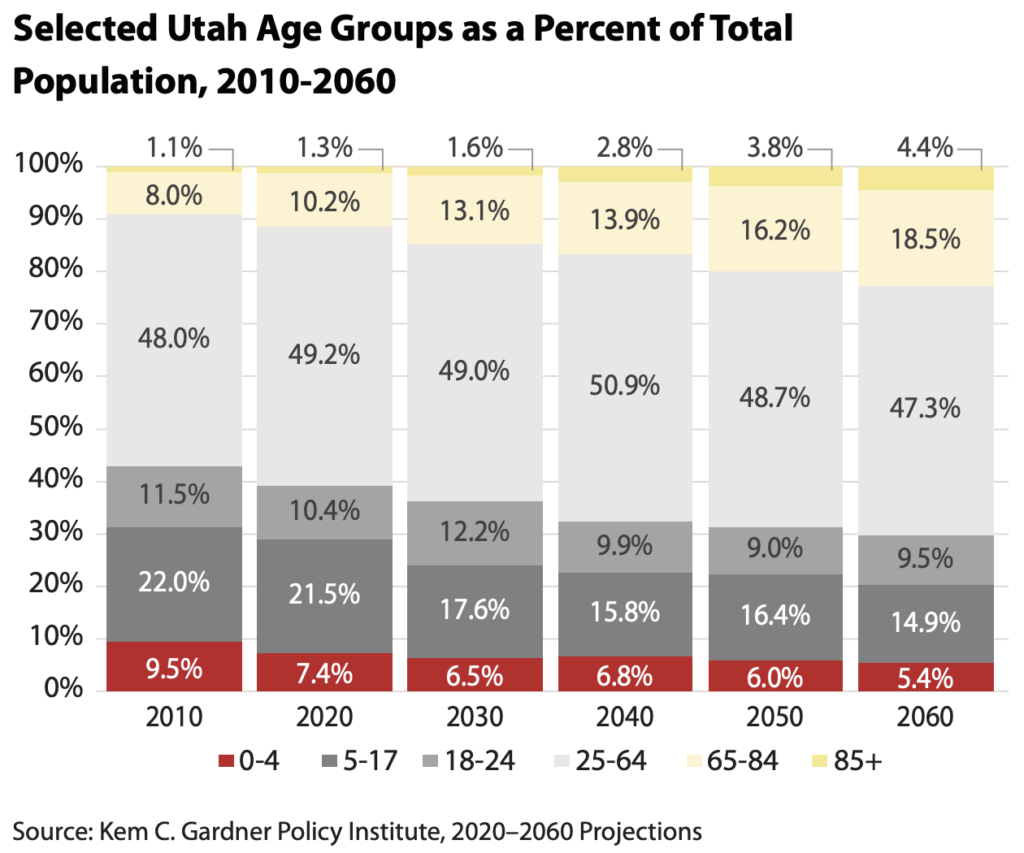Changing Dynamics
The transportation industry and the way we all get around is evolving rapidly. What worked well in the past won’t necessarily yield the same results into the future. Transportation is at the heart of individual lives and community development, and seismic changes in society, technology, and travel behavior may require new strategies and paradigms.
Transportation systems must be responsive and adaptable to future conditions in order to be resilient and sustainable. For example, if fuel prices increase, how does that change travel behavior? A multimodal transportation system needs to respond to keep Utah’s economy moving.
Societal Change
Utah is one of the fastest growing states in the nation, and for the first time in several decades, the number of people moving into Utah has surpassed the population growth created by in-state births. Utah is growing and changing and will continue to do so.
Utah is becoming increasingly diverse. We are also graying, and older adults need different options to get around. Transportation planning accounts for the needs of these diverse populations and ensures they are provided equitable and inclusive opportunities. Viewing transportation needs in this way establishes a transportation system that is accessible and functional for as many people as possible.

Equitable Planning
One example of an initiative devoted to addressing the needs of diverse populations is WFRC’s Equity Planning initiative. Goals of the initiative include ensuring inclusive engagement and participation in WFRC’s planning and decision-making processes and making sure all transportation, land use, and economic development initiatives are evaluated primarily through the lens of Access to Opportunities for all.
Changing Technology and Industry Trends
Growth and diversity aren’t the only changes coming. The transportation industry itself is at an inflection point. Technology and innovation are changing the transportation options available, as well as the ways we’ll build, maintain, and operate the system. This evolution presents a whole host of questions and possible answers are just emerging.
As Utah changes and the transportation industry also evolves, so too must policymakers and transportation officials take different actions now to create a system that can serve us well in the future. For instance, the COVID-19 pandemic altered many transportation behaviors. More and more Utahns rely on personal deliveries to acquire goods, meaning increased demand for freight services. The COVID-19 pandemic also changed the way many Utahns work. The percentage of residents who work from home has increased dramatically. This shifts the dynamics of the transportation system and these changes are incorporated in the Unified Plan. The pandemic also revealed how fragile and critical the supply chain can be. This realization mobilized a new effort to address supply chain and freight issues as part of the Unified Plan.
Utah’s transportation officials closely monitor industry trends, like the ones listed below, and consider them when creating the Unified Plan.
Mobility as a Service (MaaS) aims to consolidate all modes of transport – bike sharing, car sharing, taxis, public transit – into one unified mobile service within a single app. By means of a unified payment platform, users can easily weigh their transit options and make economically- and environmentally-conscious choices. The idea of MaaS is appealing due to the high cost of the average vehicle ($30,000) and the actual time the vehicle is used, in many situations only 5% of the time. MaaS could replace the need for a personal vehicle. There are three major advantages to MaaS:
- Reduction in traffic. With fewer car owners, there may be fewer cars on the road.
- Investing in the local economy. Every time a car is purchased, the buyer’s purchasing power is displaced from the local economy. Monies that went towards purchasing a car could be used for other goods and services.
- Job creation. With a spike in car sharing, taxis, public transit and other mobility services, local jobs may be generated.
We need to consider, but cannot yet accurately predict, the potential impact of various intelligent transportation system components, such as connected vehicle (CV) and autonomous vehicle (AV) technologies on safety, vehicle ownership, road capacity, driving distances, land use, and economic development.
Managed Motorways, or smart freeways, prevent congestion by continuously monitoring traffic flows and controlling access to the freeway with state-of-the-art ramp metering signal technologies. By applying contemporary and proven algorithms (i.e., ramp signal control formulas) that consider the system as a whole, traffic becomes more consistent and helps prevent congestion. Travel times and safety are also improved.
Another advantage of managed motorways is a decrease in breakdowns and accidents. Traffic flow breakdowns on the freeways often result in lost throughput capacity, unreliable travel times, and hazardous congested conditions. Managed Motorways can minimize such impacts.
Another important consideration in the future of transportation in Utah is parking modernization. How will the development of more advanced parking methods impact travel mode choice, land use, and economic development?
Companies and research universities alike are studying the possibilities associated with drone and air transportation, especially for deliveries. The effects of such a dramatic shift in the delivery industry must be considered in future transportation-planning efforts.
Emerging and disruptive technologies are challenging the ways we plan, build, and operate our system. This has implications for many foundational measurements of transportation performance used in planning considerations, including:
- Vehicle miles traveled (VMT) – How will new mobility options, such as ride sharing and the potential for connected and autonomous vehicles, impact VMT and how should we plan for it? And will VMT continue to be a relevant measurement?
- Vehicle ownership – As the sharing economy expands and new institutions, including shared mobility firms like Uber and Lyft, continue to grow, will owning your own vehicle remain the default?
- Safety – As technology takes a greater role in operating our vehicles, what steps need to be taken to ensure the safety of all road users?
It is also difficult to predict future travel demand due to the potential changes in transportation technologies and services. For instance:
- Transit ridership – What role will new technologies play in the efficiency, safety, and convenience of transit? With autonomous vehicles and doorstep-to-doorstep transportation services, will transit ridership increase or decrease?
- Changes in retail markets and delivery services – Will warehouse and delivery services replace current retail space? How should these impacts to the transportation network figure into future planning?
Utah’s transportation planners and policymakers will continue to monitor the trends and technologies impacting travel, and the Unified Plan process is designed to be flexible in the face of such changes.

The Human Side: Kayla
Kayla, a Utah Valley University student, rides FrontRunner from Provo to Woods Cross every day so she can help at her father’s business. She is pursuing a degree in digital marketing, and enjoys riding the train because she gets to watch videos, listen to podcasts or music, talk to the train hosts, read a good book, or do her homework. She also rides the train because she has to share a car with her sister, and riding the train saves her the money she would use to pay for gas. It is also extremely convenient because her apartment is right next to the Provo FrontRunner Station, and her work is right next to the Woods Cross Station. Kayla is impressed with how easy it is to use FrontRunner and she likes that she has travel choices in Utah so she can experience her “own little sanctuary” on the train.


